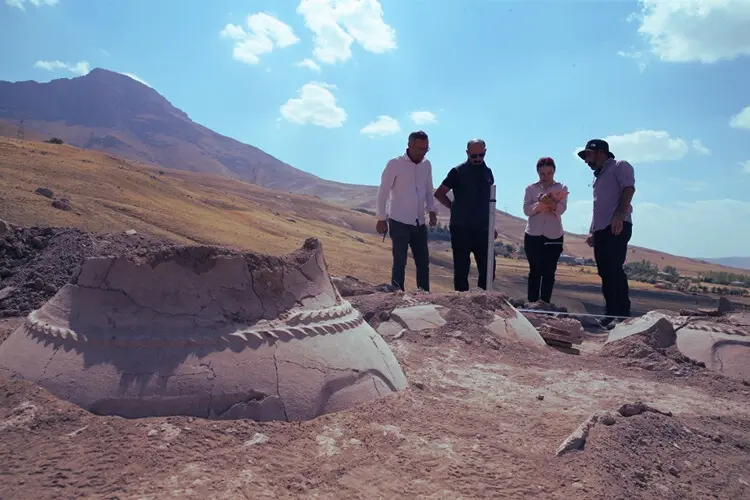Van, Turkey – September 7, 2025 – Archaeologists working in eastern Turkey have announced a remarkable discovery at the ruins of Kevenli Fortress, located at the foothills of Mount Erek in Van’s İpekyolu district. Excavations have revealed 76 large pithoi (storage jars) bearing cuneiform inscriptions, believed to have been used by the Urartians nearly 3,000 years ago for storing agricultural products, oil, and beverages.
The excavation, carried out under the supervision of the Van Museum with permission from the Ministry of Culture and Tourism, is led by Assoc. Prof. Rıfat Kuvanç of Iğdır University’s Department of Art History. A team of archaeologists, art historians, and restorers has been meticulously studying the site since last year.
A Massive Storage Center from the Urartian Era
Researchers concentrated their efforts on the southern section of the fortress, where they uncovered the jars arranged in symmetrical patterns. According to Assoc. Prof. Kuvanç, this is the largest known storage complex in Van to date:
“Although Kevenli Fortress is a relatively small settlement, the sheer number of pithoi we uncovered shows that this site had a huge storage capacity. We believe it served as a central storage hub for agricultural products produced in the Van plain. This makes Kevenli Fortress the most significant storage center discovered in the region so far.”
The jars were inscribed with cuneiform symbols indicating measurements and volumes, shedding light on how the Urartians managed agricultural resources, taxation, and trade.
Seeds, Ancient DNA, and Agricultural Insights
During the excavation, archaeobotanical analysis was prioritized. One pithos was carefully opened, revealing a limited number of preserved seed remains. These will be subjected to ancient DNA testing to determine the exact crops once stored at the fortress.

Kuvanç explained:
“We are running an ancient DNA project to identify agricultural remains. The inscriptions on the jars provide crucial details about the storage system, while the seeds give us direct evidence of Urartian farming practices. In the coming days, we will open more jars to gather a broader understanding.”
Architectural and Artistic Finds
The excavation also yielded fragments of a clay water pipe (künk), which may have been part of an ancient water distribution system, as well as Urartian palace ceramics. Among the artifacts was a red ceramic piece decorated with a lion motif, highlighting the symbolic and artistic sophistication of the Urartians.
Archaeologists also uncovered traces of wall paintings in red and black pigments on mudbrick structures, suggesting that Kevenli Fortress was once decorated with colorful murals. These findings indicate not only a practical storage function but also the cultural and artistic vibrancy of the fortress.
Significance for Urartian Studies
The discovery contributes significantly to our understanding of the Urartian Kingdom, which thrived between the 9th and 6th centuries BCE in Eastern Anatolia. While Urartu is often remembered for its fortresses, irrigation systems, and metallurgy, this find highlights its complex agricultural management and storage technologies.
Experts believe that Kevenli Fortress played a dual role: a military outpost and a central storage facility safeguarding food supplies for the surrounding population and possibly supporting long-distance trade networks across the region.
Preserving Van’s Cultural Heritage
This discovery not only enriches the history of Van but also emphasizes the region’s importance as a cradle of ancient civilizations. The Van Museum team plans to continue excavations and eventually present many of the artifacts to the public, strengthening cultural tourism in the area.

